List of Indo-European languages
From Wikipedia, the free encyclopedia
This is a list of languages in the Indo-European language family. It contains a large number of individual languages, together spoken by roughly half the world's population.
This article has multiple issues. Please help improve it or discuss these issues on the talk page. (Learn how and when to remove these messages)
|

An Indo-European language is the majority native language
An Indo-European language is a co-official and majority native language
An Indo-European language is an official but minority native language
An Indo-European language is a cultural or secondary language
An Indo-European language is not widely spoken

Non-Indo-European languages
Dotted/striped areas indicate where multilingualism is common.
Romance: Germanic:
Numbers of languages and language groups
The Indo-European languages include some 449 (SIL estimate, 2018 edition[1]) languages spoken by about 3.5 billion people or more (roughly half of the world population). Most of the major languages belonging to language branches and groups in Europe, and western and southern Asia, belong to the Indo-European language family. This is thus the biggest language family in the world by number of mother tongue speakers (but not by number of languages: by this measure it is only the 3rd or 5th biggest). Eight of the top ten biggest languages, by number of native speakers, are Indo-European. One of these languages, English, is the de facto world lingua franca, with an estimate of over one billion second language speakers. Indo-European language family has 10 known branches or subfamilies, of which eight are living and two are extinct. Most of the subfamilies or linguistic branches in this list contain many subgroups and individual languages. The relationships between these branches (how they are related to one another and branched from the ancestral proto-language) are a matter of further research and not yet fully known. There are some individual Indo-European languages that are unclassified within the language family; they are not yet classified in a branch and could constitute a separate branch. The 449 Indo-European languages identified in the SIL estimate, 2018 edition,[1] are mostly living languages. If all the known extinct Indo-European languages are added, they number more than 800 or close to one thousand. This list includes all known Indo-European languages, living and extinct.
Definition of language
The distinction between a language and a dialect is not clear-cut and simple: in many areas there is a dialect continuum, with transitional dialects and languages. Further, there is no agreed standard criterion for what amount of differences in vocabulary, grammar, pronunciation and prosody are required to constitute a separate language, as opposed to a mere dialect. Mutual intelligibility can be considered, but there are closely related languages that are also mutual intelligible to some degree, even if it is an asymmetric intelligibility. Or there may be cases where between three dialects, A, B, and C, A and B are mutually intelligible, B and C are mutually intelligible, but A and C are not. In such circumstances grouping the three dielects becomes impossible. Because of this, in this list, several dialect groups and some individual dialects of languages are shown (in italics), especially if a language is or was spoken by a large number of people and over a large land area, but also if it has or had divergent dialects.
Summary of historical development
The ancestral population and language, Proto-Indo-Europeans that spoke Proto-Indo-European, are estimated to have lived about 4500 BCE (6500 BP). At some point in time, starting about 4000 BCE (6000 BP), this population expanded through migration and cultural influence. This started a complex process of population blend or population replacement, acculturation and language change of peoples in many regions of western and southern Eurasia.[2] This process gave origin to many languages and branches of this language family. By around 1000 BCE, there were many millions of Indo-European speakers, and they lived in a vast geographical area which covered most of western and southern Eurasia (including western Central Asia). In the following two millennia the number of speakers of Indo-European languages increased even further. Indo-European languages continued to be spoken in large land areas, although most of western Central Asia and Asia Minor were lost to other language families (mainly Turkic) due to Turkic expansion, conquests and settlement (after the middle of the first millennium AD and the beginning and middle of the second millennium AD respectively) and also to Mongol invasions and conquests (which changed Central Asia ethnolinguistic composition). Another land area lost to non-Indo-European languages was today's Hungary, due to Magyar/Hungarian (Uralic language speakers) conquest and settlement. However, from about AD 1500 onwards, Indo-European languages expanded their territories to North Asia (Siberia), through Russian expansion, and North America, South America, Australia and New Zealand as the result of the age of European discoveries and European conquests through the expansions of the Portuguese, Spanish, French, English and the Dutch. (These peoples had the biggest continental or maritime empires in the world and their countries were major powers.) The contact between different peoples and languages, especially as a result of European colonization, also gave origin to the many pidgins, creoles and mixed languages that are mainly based in Indo-European languages (many of which are spoken in island groups and coastal regions).
Proto-Indo-European
- Proto-Indo-European (extinct) (see also Proto-Indo-European homeland)
- Early Proto-Indo-European (First version of Indo-European)
- Middle Proto-Indo-European ("Classical" Indo-European)
- Late Proto-Indo-European (Last version of indo-European as a spoken language before splitting into several languages that originated in the regional dialects that diverged in time, and in space, with Indo-European migrations; these languages were the direct ancestors of today's subfamilies or "branches" of descendant languages) (larger clades of Indo-European than the individual subfamilies or the way individual subfamilies are related to each other are both as-of-yet unresolved issues)
- Middle Proto-Indo-European ("Classical" Indo-European)
- Early Proto-Indo-European (First version of Indo-European)
Dating the split-offs of the main branches
Summarize
Perspective

Although all Indo-European languages descend from a common ancestor called Proto-Indo-European, the kinship between the subfamilies or branches (large groups of more closely related languages within the language family), that descend from other more recent proto-languages, is not the same because there are subfamilies that are closer or further, and they did not split-off at the same time, the affinity or kinship of Indo-European subfamilies or branches between themselves is still an unresolved and controversial issue and being investigated. However, there is some consensus that Anatolian was the first group of Indo-European (branch) to split-off from all the others and Tocharian was the second in which that happened.[3] Using a mathematical analysis borrowed from evolutionary biology, Donald Ringe and Tandy Warnow propose the following tree of Indo-European branches:[4]
- Proto-Indo-European (PIE)
- Pre-Anatolian (before 3500 BC)
- Pre-Tocharian
- Pre-Italic and Pre-Celtic (before 2500 BC)
- Pre-Armenian and Pre-Greek (after 2500 BC)
- Proto-Indo-Iranian (2000 BC)
- Pre-Germanic and Pre-Balto-Slavic; proto-Germanic (500 BC)
David W. Anthony, following the methodology of Donald Ringe and Tandy Warnow, proposes the following sequence:[4]
- Proto-Indo-European (PIE)
- Pre-Anatolian (4200 BC)
- Pre-Tocharian (3700 BC)
- Pre-Germanic (3300 BC)
- Pre-Italic and Pre-Celtic (3000 BC)
- Pre-Armenian (2800 BC)
- Pre-Balto-Slavic (2800 BC)
- Pre-Greek (2500 BC)
- Proto-Indo-Iranian (2200 BC); split between Old Iranian and Old Indic 1800 BC
The list below follows Donald Ringe, Tandy Warnow and Ann Taylor classification tree for Indo-European branches.[5] quoted in Anthony, David W. (2007), The Horse, the Wheel and Language: How Bronze-Age Riders from the Eurasian Steppes Shaped the Modern World, Princeton University Press.
Anatolian languages (all extinct)

- Proto-Anatolian
Tocharian languages (Agni-Kuči languages) (all extinct)

- Proto-Agni-Kuči ("Proto-Tocharian")
- North-Tocharian[11][12][13]
- Agnean (Tocharian A) (also called Turfanian, East Tocharian) (Agni / Ārśi)
- Kuchean (Tocharian B) (also called West Tocharian) (Kuśiññe / Kučiññe)
- South Tocharian
- Kroränian (Tocharian C) (possible)[14] (also called Krorainic, Lolanisch or South Tocharian)
- North-Tocharian[11][12][13]
Albanian language

- Proto-Albanian (extinct)
- Albanian (Modern Albanian) (shqip / gjuha shqipe) (dialect continuum)
- Gheg Albanian (gegnisht) (Northern Albanian dialect)
- Arbanasi (Albanian of Zadar, Croatia)
- Istrian Albanian (extinct)
- Upper Reka
- Tosk Albanian (toskërisht) (Southern Albanian dialect, basis of Standard Modern Albanian but not identical)
- Lab
- Cham
- Arbëresh (arbërisht) (Tosk Albanian variety of Southern Italy)
- Arvanitika (Tosk Albanian variety of Central Greece)
- Gheg Albanian (gegnisht) (Northern Albanian dialect)
- Albanian (Modern Albanian) (shqip / gjuha shqipe) (dialect continuum)
Italic languages





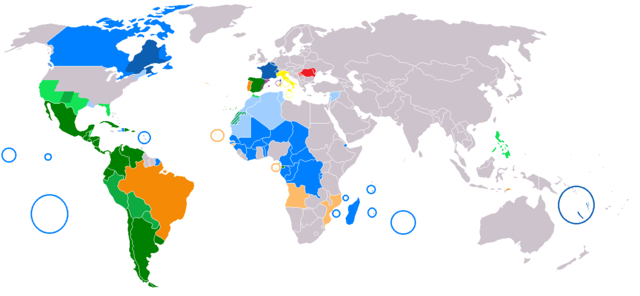
- Proto-Italic (extinct)
- Osco-Umbrian languages (Sabellic languages) (all extinct)
- Umbrian
- Oscan
- Unclassified (within Italic) (extinct)
- Latino-Faliscan languages
- Faliscan (extinct)
- Lanuvian (extinct)
- Praenestinian (extinct)
- Latin (Lingua Latina)
- Old Latin (Early Latin / Archaic Latin) (Prisca Latina / Prisca Latinitas) (extinct)
- Classical Latin (LINGVA LATINA – Lingua Latina) (extinct)
- Standard Latin
- Vulgar Latin / Colloquial Latin (sermō vulgāris)
- British Latin / Britannic Latin (not British Romance) (Latin that was spoken by the Romano-Britons)
- Judeo-Latin (Judæo-Latin)
- Late Latin
- Ecclesiastical Latin (Church Latin, Liturgical Latin) (Lingua Latina Ecclesiastica)
- Medieval Latin
- Hiberno-Latin / Hisperic Latin
- Renaissance Latin
- Neo-Latin or New Latin; (Neolatina or Lingua Latina Nova)
- Contemporary Latin (Latinitas viva)
- Neo-Latin or New Latin; (Neolatina or Lingua Latina Nova)
- Late Vulgar Latin (sermo vulgaris) (Proto-Romance) (extinct)
- Romance (dialect continuum)
- Continental Romance
- Italo-Western languages (dialect continuum)
- Italo-Dalmatian languages (dialect continuum)
- Central Italian (Italiano Centrale)
- Romanesco (Romanesco / Romano)
- Central-Northern Latian / Ciociaro[16]
- Sabino
- Central Marchigiano (Marchigiano Proper)
- Southern Italian
- Neapolitan (Napulitano – O Nnapulitano)
- Molisan[17]
- Campanian
- Beneventano
- Irpino
- Cilentano (Cilentan / Northern Cilentan)
- Apulian
- Castelmezzano
- Northern Calabrian
- Southern Latian
- Vastese
- Extreme Southern Italian / Far Southern Italian (Siculo-Calabrian)
- Southern Calabrian
- Sicilian / Sicilian Proper (Sicilianu / Lu Sicilianu)
- Cilentano Meridionale (Far Southern Cilentan)
- Salentino (Salentinu)
- Neapolitan (Napulitano – O Nnapulitano)
- Old Tuscan
- Tuscan (Toscano)
- Florentine (Fiorentino)
- Italian (Italiano / Lingua Italiana) / Standard Italian
- Judeo-Florentine
- Pistoiese
- Lucchese
- Bagitto (extinct)
- Florentine (Fiorentino)
- Corsican (Corsu / Lingua Corsa)
- Tuscan (Toscano)
- Venetian (Romance Venetian) (Vèneto / Łéngoa vèneta)
- Triestine
- Fiuman
- Talian
- Chipilo Venetian (Cipilegno)
- Judeo-Italian / Italkian (ג'יודו-איטאליאנו – Giudeo-Italiano / איטלקית – Italqit) (La'az - לעז)
- Judeo-Roman (Giudeo-Romanesco)
- Judeo-Venetian Italkian (Giudeo-Veneziano) (from Venice) (extinct)
- Illyro-Roman / Dalmatian (Transitional Western-Eastern Romance)
- Central Italian (Italiano Centrale)
- Western Romance languages (dialect continuum)
- Gallo-Romance languages (dialect continuum)
- Gallo-Italic (Cisalpine Romance)
- Emilian-Romagnol (Emiliân-Rumagnôl, Langua Emiglièna-Rumagnôla)
- Vogherese (Pavese-Vogherese)
- Lombard (Romance Lombard) (Lombard / Lumbaart)
- Eastern Lombard (Lombard)
- Bressano / Bresciano (in Brescia Province)
- Bergamasco (Bergamàsch) (in Bergamo Province)
- Cremish (Cremàsch)
- Western Lombard (Lombard / Lumbaart)
- Milanese (Milanés) / Meneghin (Macromilanese)
- Brianzöö (Lombardo-prealpino occidentale – macromilanese)
- Bustocco-Legnanese
- Comasco-Lecchese (Lombardo-prealpino occidentale)
- Varesino / Bosin (Lombardo-Prealpino Occidentale)
- Ticinese (Lombardo Alpino)
- Southwestern Lombard (Basso-Lombardo Occidentale)
- Pavese (in Pavia area) (strong influence from Emiliano-Romagnolo language)
- Lodigiano
- Cremunés (in Cremona area) (strong influence from Emiliano-Romagnolo language)
- Spasell (extinct)
- Eastern Lombard (Lombard)
- Novarese (Nuares) (Lombardo-Prealpino Occidentale – Macromilanese)
- Piedmontese (Piemontèis)
- Judaeo-Piedmontese (Giudeo-Piemontese) (from Piedmont) (extinct)
- Ligurian (Romance Ligurian) (Ligure / Lengua Ligure / Zeneize)
- Genoese Ligurian (Central Ligurian) (Zeneize)
- Intemelio
- Monégasque (Munegascu)
- Brigasc
- Royasc (Roiasc)
- Intemelio
- Genoese Ligurian (Central Ligurian) (Zeneize)
- Gallo-Italic of Basilicata
- Gallo-Italic of Sicily
- Gallo-Rhaetian
- Rhaeto-Romance
- Oïl (Northern Gallo-Romance) (Langues d'Oïl) (dialect continuum)
- Arpitan (Arpetan / Francoprovençâl / Patouès)
- Valdôtain (Arpitan of Aosta Valley)
- Savoyard
- Vaudois
- Dauphinois
- Lyonnais
- Jurassien (Southern Franc-Comtois)
- Faetar-Cellese (Arpitan of Apulia) (Faetar-Cigliàje)
- Old French (Franceis / François / Romanz) (extinct)
- Middle French (François/Franceis)
- Burgundian-Morvandeau (Bregognon)
- Frainc-Comtois/Jurassien (Frainc-Comtou/Jurassien)
- Francien / Francilien (Île de France Langue d'Oïl)
- French (Français / Langue Française)
- European French
- American French
- Canadian French
- Acadian French (Français Acadien)
- Chiac
- Louisiana French (Cajun French) (Français Louisianais)
- Brayon French
- Québec French (Français Québécois
- Joual
- Ontario French
- New England French (Français de Nouvelle-Angleterre)
- Missouri French / Illinois Country French ("Paw-Paw French")
- Acadian French (Français Acadien)
- Newfoundland French (Français Terre-Neuvien)
- Frenchville French (Français de Frenchville)
- Canadian French
- Saint-Barthélemy French (Patois Saint-Barth)
- Haitian French (Français Haïtien)
- Guianese French
- African French / Sub-Saharan African French (Français Africain)
- Maghreb French / North African French
- Indian French (Français Indien)
- South East Asian French
- Orleanais (Orléanais)
- Blésois
- French (Français / Langue Française)
- Berrichon (Berrichonne)
- Oïl Bourbonnais (Bourbonnais d'Oïl)
- Champenois (Champaignat)
- Lorrain (Lorrain / Gaumais)
- South Norman
- Angevin (Angevin)
- Gallo (Galo)
- Old Norman (Old Romance Norman)
- Norman (Romance Norman) (Normaund)
- Anglo-Norman / Anglo-Norman French (Norman) (extinct)
- Auregnais / Aoeur'gnaeux (extinct)
- Guernésiais / Dgèrnésiais
- Jèrriais
- Law French
- Sercquiais
- Cauchois (spoken in the Pays de Caux)
- Augeron (spoken in the Pays d'Auge)
- Cotentinais (spoken in Cotentin)
- Anglo-Norman / Anglo-Norman French (Norman) (extinct)
- Norman (Romance Norman) (Normaund)
- Old Norman (Old Romance Norman)
- Picard (Picard / Chti / Chtimi / Rouchi / Roubaignot)
- Amiénois
- Vermandois
- Thiérache
- Beauvaisis
- "Rouchi" – Tournaisis (Valenciennois)
- Walloon (Walon)
- Poitevin-Saintongeais (Poetevin-Séntunjhaes)
- Poitevin (Poetevin)
- Saintongeais (Saintonjhais)
- Zarphatic (Judaeo-French) (צרפתית – Tzarfatit) (extinct)
- Middle French (François/Franceis)
- Arpitan (Arpetan / Francoprovençâl / Patouès)
- Moselle Romance (extinct)
- Gallo-Italic (Cisalpine Romance)
- British Romance (?) (language of the Romano-Britons or Romanised Britons) (extinct)
- Old Occitan / Old Provençal (Proensals / Proençal / Romans / Lenga d'Òc / Lemosin) (extinct)
- Occitan (Occitan / Lenga d'Òc / Lemosin / Provençal)
- Provençal (Provençau (classical norm) / Prouvençau (mistralian norm))
- Niçard / Nissart
- Shuadit (Judaeo-Provençal / Judaeo-Occitan) (Chouadit) (שואדית – Shuadit) (extinct)
- Niçard / Nissart
- Vivaro-Alpine (Alpine Provençal, Gavòt) (Vivaroalpenc / Vivaroaupenc)
- Auvergnat (Auvernhat)
- Limousin (Lemosin)
- Lengadocian (Northern-Central) (Lengadocian / Lenga d'Oc)
- Provençal (Provençau (classical norm) / Prouvençau (mistralian norm))
- Occitan (Occitan / Lenga d'Òc / Lemosin / Provençal)
- Gascon (Romance Gascon) (Gasco)
- Old Catalan (Catalanesch) (extinct)
- Catalan (Modern Catalan) (Catalan–Valencian–Balearic) (Català / Llengua Catalana)
- Catalanic (Judaeo-Catalan) (קטלאנית יהודית – Judeocatalà / קאטאלנית – Catalànic) (extinct)
- Iberian Romance languages / Hispano-Romance (dialect continuum)[18]
- Andalusi Romance (extinct) (dialect continuum)[19]
- Navarro-Aragonese (extinct)
- Aragonese (Aragonés / Luenga Aragonesa / Fabla Aragonesa)
- Eastern Aragonese
- Central Aragonese
- Western Aragonese
- Southern Aragonese
- Judaeo-Aragonese (Chodigo-Aragonés) (extinct)
- Ebro Valley Aragonese (extinct)
- Navarrese (extinct)
- Old Riojan (extinct)
- Valencian Aragonese (extinct)
- Aragonese (Aragonés / Luenga Aragonesa / Fabla Aragonesa)
- Navarro-Aragonese (extinct)
- Western Iberian Romance / Western Hispano-Romance (dialect continuum)
- Castilian (dialect continuum)
- Old Castilian (Romance Castellano) (extinct)
- Spanish / Castilian / Standard Spanish (Español / Castellano / Lengua Española / Lengua Castellana)
- Peninsular Spanish / Spanish of Spain (European Spanish, Spanish of Europe)
- American Spanish / Hispanic American Spanish (Spanish of the Americas)
- Philippine Spanish
- Saharan Spanish
- Equatoguinean Spanish / Equatorial Guinea Spanish
- Castilian Extremaduran (Southern-Central Extremaduran)/ Castúo
- Ladino / Judaeo-Spanish (לאדינו – Ladino / גﬞודﬞיאו־איספאנייול – Djudeo-Espanyol / Judeoespañol)
- Spanish / Castilian / Standard Spanish (Español / Castellano / Lengua Española / Lengua Castellana)
- Old Castilian (Romance Castellano) (extinct)
- Astur-Leonese (Asturllionés / Astur-Llionés / Llengua Astur-Llionesa)
- Eastern Astur-Leonese
- Cantabrian (Romance Cantabrian) (Cántabru / Montañés)
- Western Cantabrian
- Central Cantabrian
- Pasiego (Pasiegu)
- Montañés
- Eastern Cantabrian
- Far-Eastern Leonese
- Bejarano
- Palra d'El Rebollal
- Serrano / Habla de la Sierra de Francia
- Riberan / Riveran / Arribenian / Riberenian
- Extremaduran (Estremeñu)
- Cantabrian (Romance Cantabrian) (Cántabru / Montañés)
- Old Leonese (extinct)
- Leonese (Llionés)
- Mirandese (Mirandés / Lhengua Mirandesa)
- Central Mirandese
- Raiano Mirandese
- Sendinese Mirandese
- Asturian (Asturianu)
- West Asturian
- Central Asturian
- East Asturian
- Eastern Astur-Leonese
- Galician–Portuguese (Old Galician–Old Portuguese) (extinct)
- Galician (Galego / Lingua Galega
- Eonavian
- Fala
- Portuguese (Português / Língua Portuguesa)
- European Portuguese
- Alentejan
- Estremenho
- Judaeo-Portuguese (Judeu-Português) (extinct)
- Minderico
- Nortenho
- Latin American Portuguese
- African Portuguese
- Asian Portuguese
- Mixed Portuguese-Spanish
- European Portuguese
- Castilian (dialect continuum)
- Andalusi Romance (extinct) (dialect continuum)[19]
- Gallo-Romance languages (dialect continuum)
- Italo-Dalmatian languages (dialect continuum)
- Eastern Romance languages
- Pannonian Romance (extinct)
- Daco-Roman (dialect continuum)
- Proto-Romanian / Common Romanian
- Aromanian (Rrãmãneshti / Armãneashti / Armãneshce / Limba Rrãmãniascã / Limba Armãneascã / Limba Armãneshce)
- Megleno-Romanian (Vlăhește)
- Old Romanian (Daco-Romanian)
- Modern Romanian (Limba Română / Românește)
- Istro-Romanian (Rumârește / Vlășește)
- Proto-Romanian / Common Romanian
- Italo-Western languages (dialect continuum)
- Southern Romance
- Insular Romance (dialect continuum)
- Sardinian (Sardu or Lingua Sarda / Limba Sarda)
- Logudorese-Nuorese
- Campidanese
- Cagliaritano (Casteddaiu)
- Sardinian (Sardu or Lingua Sarda / Limba Sarda)
- African Romance (extinct)
- Disputed Italo-Western
- Franco-Italian (extinct)
- Disputed Italo-Western
- Insular Romance (dialect continuum)
- Continental Romance
- Romance (dialect continuum)
- Classical Latin (LINGVA LATINA – Lingua Latina) (extinct)
- Old Latin (Early Latin / Archaic Latin) (Prisca Latina / Prisca Latinitas) (extinct)
- Unknown Italic (extinct)
- Osco-Umbrian languages (Sabellic languages) (all extinct)
Celtic languages

maximal Celtic expansion, by 275 BCE
the six Celtic nations which retained significant numbers of Celtic speakers into the Early Modern period

- Proto-Celtic (extinct)
- Continental Celtic (extinct)
- Insular Celtic
- Brittonic / British (P Celtic)
- Common Brittonic / Old Brittonic (extinct)
- Southwestern Brittonic (dialect continuum)
- Old Cornish (extinct)
- Middle Cornish (extinct)
- Cornish (Modern Cornish) (Kernowek)
- Middle Cornish (extinct)
- Old Breton (extinct)
- Middle Breton (extinct)
- Breton (Modern Breton) (Brezhoneg)
- Trégorrois
- Batz-sur-Mer (extinct)
- Breton (Modern Breton) (Brezhoneg)
- Middle Breton (extinct)
- Old Cornish (extinct)
- Western Brittonic (Dialect continuum)
- Old Welsh (extinct)
- Middle Welsh (extinct)
- Welsh (Modern Welsh) (Cymraeg / y Gymraeg)
- Middle Welsh (extinct)
- Cumbric (extinct)
- Ivernic? (hypothetical) (extinct)
- Old Welsh (extinct)
- Southwestern Brittonic (dialect continuum)
- Pictish (extinct)
- Common Brittonic / Old Brittonic (extinct)
- Goidelic (Q Celtic) (dialect continuum)
- Primitive Irish (extinct)
- Old Irish (Goídelc) (extinct)
- Middle Irish (Gaoidhealg) (extinct)
- Irish (Modern Irish) (Gaeilge) / Irish Gaelic
- Standard Irish (An Caighdeán Oifigiúil)
- Leinster Irish (in Leinster / Laighin) (extinct)
- Connacht Irish (Gaeilge Chonnacht)
- Munster Irish (Gaelainn na Mumhan
- Newfoundland Irish (in Newfoundland) (extinct)
- Ulster Irish (Canúint Uladh) (in Ulster) (Tuaisceartach – Northern)
- Antrim Irish (extinct)
- Ulster Irish (Canúint Uladh) (in Ulster) (Tuaisceartach – Northern)
- Newfoundland Irish (in Newfoundland) (extinct)
- Scottish Gaelic (Gàidhlig) (not to be confused with Scots or Scottish English)
- Beurla Reagaird
- Mid-Minch Gaelic (Gàidhlig Meadhan na Mara)
- Hebridean / Hebridean Gaelic
- East Sutherland Gaelic (Gàidhlig Chataibh) (extinct)
- Canadian Gaelic / Cape Breton Gaelic
- Galwegian Gaelic (extinct)
- Arran Gaelic (extinct)
- Deeside Gaelic (extinct)
- Manx Gaelic (Gaelg / Gailck)
- Northern Manx (Gaelg y Twoaie)
- Douglas Manx (?) (Gaelg y Doolish)
- Southern Manx (Gaelg y Jiass)
- Irish (Modern Irish) (Gaeilge) / Irish Gaelic
- Middle Irish (Gaoidhealg) (extinct)
- Old Irish (Goídelc) (extinct)
- Primitive Irish (extinct)
- Brittonic / British (P Celtic)
Hellenic languages

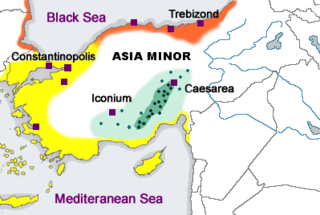
- Proto-Greek (extinct)
- Mycenaean Greek (extinct)
- Ancient Greek (Classical Greek) (Ἑλληνική – Hellēnikḗ / Ἑλληνική γλῶσσα – Hellēnikḗ glōssa) (includes Homeric Greek) (extinct) (Dialect continuum)
- Aeolic Greek (extinct)
- Arcadocypriot (extinct)
- Pamphylian Greek (in Pamphylia) (extinct)
- Ionic (extinct)
- Attic (extinct)
- Koine Greek (ἡ κοινὴ διάλεκτος – hē koinḕ diálektos / Kοινὴ – Koinḕ)
- Biblical Greek (Biblical Forms of Koine Greek)
- New Testament Greek (Greek of New Testament)
- Septuagint Greek (Greek of Septuagint (Old Testament))
- Jewish Koine Greek (Greek of Byzantine Jews)
- Medieval Greek (Byzantine Greek / Constantinopolitan Greek)
- Greek (Modern Greek) (ελληνικά – Elliniká) (Dialect continuum)
- Katharevousa (Καθαρεύουσα – Katharevousa)
- Demotic (Δημοτική γλώσσα – Dimotikí glṓssa)
- Southern dialects
- Maniot (in Mani Peninsula) (archaic dialect)
- Himariote
- Cretan
- Cypriot
- Central Greek ("Semi-Northern") (Transitional Southern-Northern Greek)
- Northern dialects
- Southern dialects
- Greco-Australian
- Silliot
- Pharasiot
- Pontic Greek (ποντιακά – Pontiaká)
- Mariupolitan Greek (Rumeíka)
- Cappadocian Greek
- Italiot Greek
- Griko / Salentinian Greek (Γκρίκο – Gríko) (
- Calabrian Greek (Γκραίκο – Graíko)
- Yevanic (Judæo-Greek / Romaniote) (probably extinct)
- Greek (Modern Greek) (ελληνικά – Elliniká) (Dialect continuum)
- Biblical Greek (Biblical Forms of Koine Greek)
- Koine Greek (ἡ κοινὴ διάλεκτος – hē koinḕ diálektos / Kοινὴ – Koinḕ)
- Attic (extinct)
- Doric (extinct)
- Northwest Doric / Northwest Greek (extinct)
- Locrian Greek (in Locris) (extinct)
- Achaean Doric (in Achaea) (North Coast of Peloponnese) (extinct)
- Tsakonian (Tσακώνικα – Tsakṓnika / A Tσακώνικα γρούσσα – A Tsakṓnika gloússa)
- Northwest Doric / Northwest Greek (extinct)
- Ancient Macedonian[21] (extinct)
- Ancient Greek (Classical Greek) (Ἑλληνική – Hellēnikḗ / Ἑλληνική γλῶσσα – Hellēnikḗ glōssa) (includes Homeric Greek) (extinct) (Dialect continuum)
- Mycenaean Greek (extinct)
Armenian language


- Proto-Armenian (extinct)
- Classical Armenian (Old Armenian) (գրաբար հայերէն – Krapar Hayeren / Grabar Hayeren գրաբար – Krapar / Grabar) (Classical language, High culture language, official language of the Armenian Kingdom, liturgical or sacred language of the Armenian Apostolic Church and the Armenian Catholic Church)
- Liturgical Armenian
- Middle Armenian
- Judeo-Armenian
- Armenian (Modern Armenian) (հայերէն or հայերեն – Hayeren) (dialect continuum)
- Western Armenian (արեւմտահայերէն – Arevmdahayerēn) (dialect continuum)
- Akn
- Homshetsi
- Karin / Upper Armenia (Bardzr Hayk')
- Kharberd-Yerznka (Tsopk') (nearly extinct)
- Malatia (extinct)
- Mush
- Nor-Nakhichevan
- Shabin–Karahisar
- Eastern Armenian (արևելահայերեն – Arevelahayeren) (dialect continuum)
- Western Armenian (արեւմտահայերէն – Arevmdahayerēn) (dialect continuum)
- Classical Armenian (Old Armenian) (գրաբար հայերէն – Krapar Hayeren / Grabar Hayeren գրաբար – Krapar / Grabar) (Classical language, High culture language, official language of the Armenian Kingdom, liturgical or sacred language of the Armenian Apostolic Church and the Armenian Catholic Church)
Germanic languages



- Proto-Germanic (extinct)
- East Germanic / Oder-Vistula Germanic (extinct)
- Northwest Germanic
- West Germanic
- Elbe Germanic
- Langobardic / Lombardic (extinct)
- Suebian (extinct) [24]
- High German languages
- Old High German
- Middle High German
- Early New High German
- New High German
- Central German / Middle German
- Standard German
- Upper German
- East Franconian
- South Franconian (Südfränkisch)
- Swabian-Alemannic
- Bavarian / Austro-Bavarian
- Northern Bavarian / North Bavarian
- Central Bavarian
- Southern Bavarian
- New High German
- Early New High German
- Middle High German
- Old High German
- High German languages
- Weser–Rhine Germanic
- Low Franconian languages
- Old Low Franconian
- Limburgish
- Central Limburgish
- East Limburgish
- East Limburgish - Ripuarian transitional area
- West Limburgish
- West Low Franconian / North Low Franconian
- Limburgish
- Old Low Franconian
- North Sea Germanic
- Old Low German
- Middle Low German
- Low German
- Missingsch
- Low Saxon
- East Low German
- East Pomeranian (not to be confused with Slavic Pommeranian, the Slavic Pomeranians language)
- Northern Low German
- Low German
- Middle Low German
- Anglo-Frisian languages
- Anglic languages
- Old English (extinct)
- Mercian
- Northumbrian
- Middle English (extinct)
- Northumbrian
- Early Scots (extinct)
- Middle Scots (extinct)
- Scots (mainly Brittonic languages and also Scottish Gaelic substrates in the Scottish Lowlands and mainly Scottish Gaelic substrate in the Scottish Highlands)
- Middle Scots (extinct)
- Kentish
- Fingallian (extinct)
- Yola (extinct)
- Early Scots (extinct)
- Early Modern English
- Modern English
- English
- Standard English
- North American English
- Caribbean English
- South Atlantic English
- Falkland Islands English
- Australian English
- New Zealand English
- Solomon Islands English
- Fiji English
- Palauan English
- Jewish English varieties
- Asian English
- East Asian English
- South Asian English
- Southeast Asian English
- African English
- Antarctic English
- English
- Modern English
- Northumbrian
- Frisian languages
- Old Frisian
- Middle Frisian
- North Frisian
- East Frisian
- Saterland Frisian
- Harlingerland Frisian (extinct)
- Upgant Frisian (extinct)
- Wangerooge Frisian (extinct)
- Wursten Frisian (extinct)
- West Frisian
- Middle Frisian
- Old Frisian
- Old English (extinct)
- Anglic languages
- Old Low German
- Elbe Germanic
- West Germanic
- North Germanic
- Proto-Norse/Proto-Scandinavian (extinct)
- Old Norse (extinct)
- East Scandinavian
- Old East Norse (extinct)
- Old Gutnish (extinct)
- Old Swedish (extinct)
- Old Danish (extinct)
- Dalecarlian / Dalarna dialect
- Jamtlandic
- Old East Norse (extinct)
- West Scandinavian
- Old West Norse (extinct)
- Old Norwegian (extinct)
- Middle Norwegian (extinct)
- Old Norwegian (extinct)
- Old West Norse (extinct)
- East Scandinavian
- Old Norse (extinct)
- Proto-Norse/Proto-Scandinavian (extinct)
Balto-Slavic languages
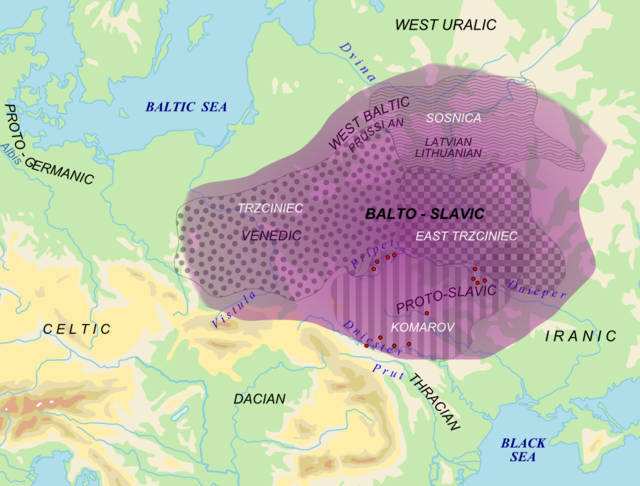
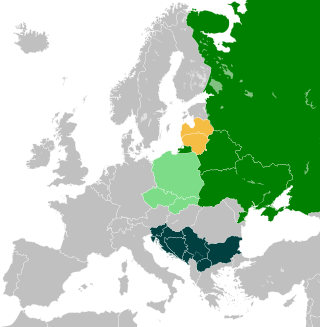



Baltic languages
- Proto-Baltic (extinct)
- Dnieper-Oka (extinct)
- Golyad (extinct)
- Eastern Baltic
- Old Latvian (extinct)
- Latvian
- Selonian (extinct)
- Semigallian (extinct)
- Old Lithuanian (extinct)
- Lithuanian
- Highland Lithuanian / Aukštaitian
- Lowland Lithuanian / Samogitian
- Lithuanian
- Curonian (extinct)
- Old Latvian (extinct)
- Western Baltic
- Old Prussian / Baltic Prussian (extinct)
- Skalvian (extinct)
- Galindian (extinct)
- Sudovian (extinct)
- Pomeranian Baltic (extinct)
- Dnieper-Oka (extinct)
Slavic languages
- Proto-Slavic (extinct)
- East Slavic languages
- Old Novgorodian (extinct)
- Old East Slavic (extinct)
- Ruthenian (extinct)
- Rusyn / Carpathian Rusyn
- Lemko
- Pannonian Rusyn / Bačka Rusyn
- Ukrainian
- Belarusian
- Russian
- Rusyn / Carpathian Rusyn
- Ruthenian (extinct)
- Old East Slavic (extinct)
- Old Novgorodian (extinct)
- West Slavic languages
- Lechitic
- East Lechitic
- Old Polish (extinct)
- Pomeranian
- Kashubian
- Slovincian (extinct)
- West Lechitic (extinct)
- Silesian
- East Lechitic
- Czech-Slovak
- Sorbian
- Lechitic
- South Slavic languages
- Western South Slavic
- Eastern South Slavic /
- Old Church Slavonic (extinct)
- Bulgarian-Macedonian
- Bulgarian
- Western Bulgarian
- Eastern Bulgarian
- Macedonian
- Kumanovo dialect
- Kriva Palanka dialect
- Skopska Crna Gora dialect
- Tetovo dialect
- Maleševo-Pirin dialect
- Štip-Kočani dialect
- Strumica dialect
- Ser-Drama-Lagadin-Nevrokop dialect
- Solun-Voden dialect
- Kostur dialect
- Nestram-Kostenar dialect
- Prilep-Bitola dialect
- Kičevo-Poreče dialect
- Skopje-Veles dialect
- Lower Prespa dialect
- Upper Prespa dialect
- Ohrid dialect
- Struga dialect
- Vevčani-Radožda dialect
- Debar dialect
- Galičnik dialect
- Reka dialect
- Gostivar dialect
- Spoken Macedonian
- Bulgarian
- East Slavic languages
Indo-Iranian languages
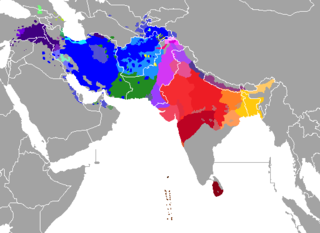
- Proto-Indo-Iranian (extinct)
- Iranian languages
- Nuristani languages
- Indo-Aryan languages
- Badeshi (unclassified)
Iranian languages


- Proto-Iranian
- Eastern Iranian languages
- Northeastern Iranian languages
- Old Northeast Iranian
- Scytho-Sarmatian
- Cimmerian (extinct)
- Pontic Scythian (extinct)
- Sarmatian (extinct)
- Alanic (extinct)
- Ossetian
- Iron Ossetian
- Digor Ossetian
- Jassic (extinct)
- Ossetian
- Alanic (extinct)
- Scytho-Khotanese (extinct)
- Tumshuqese (extinct)
- Kanchaki (extinct)
- Khotanese (extinct)[31]
- Khwarazmian / Chorasmian[32] (extinct)
- Sogdian (extinct)
- Scytho-Sarmatian
- Old Northeast Iranian
- Southeastern Iranian languages
- Old Southeast Iranian
- Avestan (extinct)
- Old Avestan / "Gathic Avestan"[33] (extinct)
- Young Avestan / Younger Avestan (extinct)[34][35] (extinct)
- Old Avestan / "Gathic Avestan"[33] (extinct)
- Old Pakhto
- Pakhto / Pashto / Pathan
- Northern Pashto
- Northern dialect
- Yusufzai dialect
- Southern Pashto
- Durrani dialect
- Northern Pashto
- Wanetsi
- Pakhto / Pashto / Pathan
- Ormuri-Parachi
- Bactrian (extinct)[36]
- Munji
- Yidgha
- Sarghulami (extinct)
- Rushani
- Shughni / Khughni
- Sanglechi-Ishkashimi / Zebaki[37]
- Wakhi [37]
- Avestan (extinct)
- Old Southeast Iranian
- Northeastern Iranian languages
- Western Iranian languages
- Northwestern Iranian languages / Northern Western Iranian
- Median / Medic (extinct)
- Kurdish
- Zaza-Gorani
- Old Azeri (extinct)
- Talysh
- Gozarkhani
- Kajali
- Koresh-e Rostam
- Razajerdi
- Shahrudi
- Ashtiani
- Judeo-Hamedani-Borujerdi
- Khunsari
- Northwestern Fars
- Judeo-Golpaygani (extinct)
- Gazi
- Soi / Sohi
- Sivandi
- Natanzi
- Zoroastrian Dari
- Nayini / Na'ini / Biyabanak
- Khuri
- Balochi
- Parthian (extinct)
- Median / Medic (extinct)
- Southwestern Iranian languages/Southern Western Iranian
- Old Persian (𐎠𐎼𐎹 – Ariya) (extinct)
- Middle Persian (𐭯𐭠𐭫𐭮𐭩𐭪 – Pārsīk or Pārsīg) (extinct)
- Persian
- Iranian Persian
- Dari / Afghanistan Persian
- Pahlavni / Pahlavani (extinct)
- Judeo-Persian
- Aimaq / Aimaqi / Aimaq Persian
- Tajik / Tajiki Persian
- Tat / Caucasus Tat / Persian Tat
- Muslim/Christian Tat
- Judeo-Tat / Judeo-Persian Tat
- Persian
- Middle Persian (𐭯𐭠𐭫𐭮𐭩𐭪 – Pārsīk or Pārsīg) (extinct)
- Kuhmareyi
- Luri
- Southern Luri
- Northern Luri / Central Luri
- Bakhtiari
- Old Persian (𐎠𐎼𐎹 – Ariya) (extinct)
- Khuzestani Persian
- Dezfuli–Shushtari
- Achomi
- Garmsiri
- Bashkardi / Bashagerdi / Bashaka
- Kumzari
- Khargi
- Old Kazeruni (extinct)
- Northwestern Iranian languages / Northern Western Iranian
- Unclassified Indo-Iranian
- Kambojan (extinct)
- Eastern Iranian languages
Nuristani languages


- Proto-Nuristani (extinct) [38][39]
Indo-Aryan languages


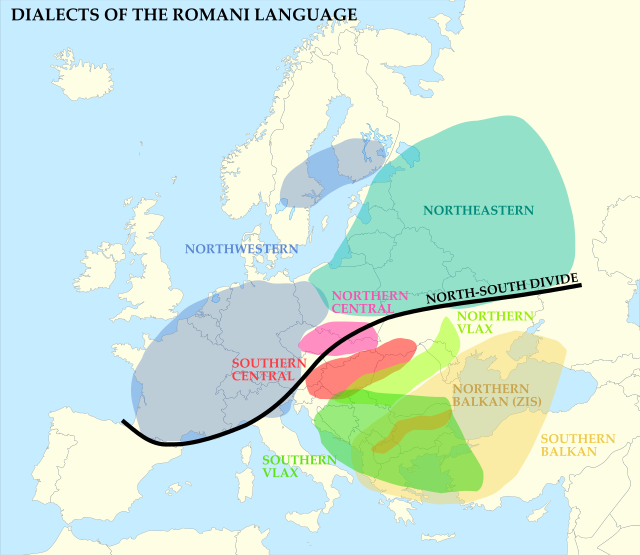
- Proto-Indo-Aryan (extinct)
- Old Indo-Aryan (extinct)
- Mitanni-Aryan (extinct)
- Early Old Indo-Aryan – Vedic Sanskrit / Rigvedic Sanskrit
- Ashokan Prakrit (extinct)
- Late Old Indo-Aryan – Sanskrit
- Middle Indo-Aryan (extinct)
- Dardic
- Gandhari Prakrit (extinct)
- Niya Prakrit[14][40] / Kroraina Prakrit / Niya Gāndhārī (extinct)
- Chitral languages
- Kashmiri / Koshur
- Kohistani languages
- Pashayi / Pashai
- Kunar languages
- Dameli
- Gawar-Bati / Narsati / Aranduyiwar
- Nangalami / Grangali
- Shumashti
- Shina languages
- Gandhari Prakrit (extinct)
- North-Western Indo-Aryan
- Punjabi languages
- Sindhi languages
- Northern Indo-Aryan
- Western Indo-Aryan
- Gurjar apabhraṃśa
- Rajasthani
- Gujarati
- Old Gujarati (extinct)
- Jandavra / Jhandoria
- Vaghri / Waghri / Baghri
- Aer
- Sauraseni Prakrit (extinct)
- Vasavi / Vasavi Bhil
- Bhil
- Khandeshi
- Domari-Romani
- Domari
- Seb Seliyer
- Romani
- Balkan Romani
- Vlax Romani
- Northern Romani
- Carpathian Romani
- Romungro / Romungro Romani
- Roman / Roman Romani
- Vend / Vend Romani
- East Slovak Romani
- West Slovak Romani
- South Polish Romani
- Sinte Romani (Sintenghero / Tschib(en) / Sintitikes / Manuš / Romanes)
- Welsh-Romani
- Baltic Romani
- Carpathian Romani
- Gurjar apabhraṃśa
- Central Indo-Aryan
- Sauraseni Prakrit (extinct)
- Western Hindi
- Parya
- Ardhamagadhi Prakrit (extinct)
- Awadhi
- Bagheli
- Surgujia / Sargujia / Surgujia Chhattisgarhi / Bhandar
- Chhattisgarhi
- Sauraseni Prakrit (extinct)
- Eastern Indo-Aryan
- Magadhi Prakrit (extinct)
- Pali (extinct)
- Apabhramsa Avahatta / Abahattha (extinct)
- Bihari languages
- Bhojpuri
- Mauritian Bhojpuri
- Caribbean Hindustani
- Guyanese Hindustani
- Sarnami Hindustani / Sarnami Hindoestani
- Magahi / Magadhi
- Khortha
- Maithili
- Kudmali / Kurmali / Panchpargania / Tamaria (কুর্মালী]] – কুড়মালি]] – Kur(a)mālī)
- Musasa
- Sadri / Sadani / Nagpuri
- Oraon Sadri
- Bhojpuri
- Bengali-Assamese languages
- Bengali
- Varendri
- Rarhi
- Manbhumi
- Bangali / Vangi
- Dhakaiya Kutti or Puran Dhakaiya
- Noakhailla
- Sylheti
- Chittagonian / Chattal
- Rohingya
- Kurmukar
- Bishnupriya Manipuri
- Chakma
- Tangchangya
- Hajong
- Kharia Thar
- Lodhi (?)
- Bengali
- Kamarupi Prakrit / Kamrupi Apabhramsa (extinct)
- Surjapuri / Surajpuri
- Rangpuriya / Rangpuri / Rajbanshi / Rajbangsi / Kamtapuri / Deshi Bhasha / Uzani
- Old Assamese
- Odia languages
- Old Odia
- Odia proper
- Adivasi Oriya / Adivasi Odia
- Bodo Parja / Jharia
- Sambalpuri / Western Odia
- Reli / Relli
- Kupia
- Old Odia
- Bihari languages
- Apabhramsa Avahatta / Abahattha (extinct)
- Halbic
- Southern Indo-Aryan
- Insular Indo-Aryan
- Dardic
- Middle Indo-Aryan (extinct)
- Unclassified
- Old Indo-Aryan (extinct)
Unclassified Indo-European languages (all extinct)
Indo-European languages whose relationship to other languages in the family is unclear
Possible Indo-European languages (all extinct)
Unclassified languages that may have been Indo-European or members of other language families (?)
See also
References
External links
Wikiwand - on
Seamless Wikipedia browsing. On steroids.
